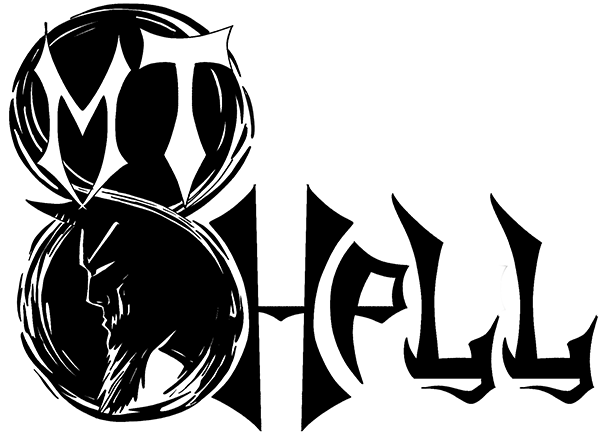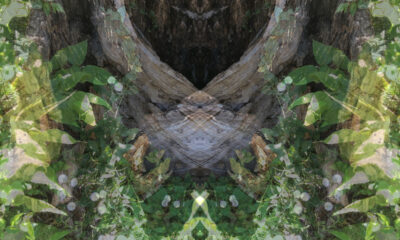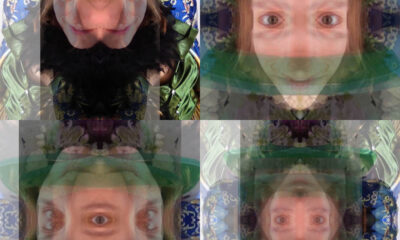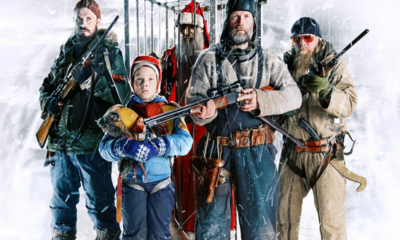
Daphne Fauber’s Ballerina will have your nuts crackin’
Before you take down that Christmas tree (it’s not July yet!), crack one more yuletide tale open. We’ve got an advance copy of Eerie Christmas 3 by Black Hare Press and I was able to sit down with author Daphne Fauber to discuss their story, ‘The Ballerina’. This review is two parts–Part 1 the story of The Ballerina and Part 2 the overall feel of the Eerie Christmas 3 anthology.
The Ballerina: Get them nuts a crackin’
Full Disclosure: Although Daphne is a writer for this site, my review is independent and there’s nothing in trade, etc.
One of the perks of owning a horror business is that you can meet cool people in horror. Daphne is one of the most talented new writers I have seen in a long time. Rarely do we find someone who is both a product of their generation and able to navigate their artistic world through that lens–yet not being controlled by that lens.

Prose can be important and a clean, crisp copy is something readers can immediately get into. Daphne’s writing is not quite minimalist but it is crisp. If you’ve read Ray Carver before and seen what Lish did to his writing (a great before/after snapshot is found in Beginners), then you’ll have the measure of Daphne’s prose–not Lish minimalistic and not Carver’s original style, but the happy medium. It gets to the point. It is what Bruce Lee would call ‘Economy in motion’.
Not only does her writing push the story without the weight of ‘extra’, but she hits the crowd running (oh, Van Halen drop!) from the first line.
“Tiny pointe shoes danced across the floorboards, each step met with the plink of ceramic against wood.”
Daphne Fauber, The Ballerina. Eerie Christmas 3
The setting comes at us with intentful action. You can see this happening with little effort of the imagination. The start of the story comes on like the opening of the Nutcracker. We see a (mostly) unnamed character. We know them only as The Ballerina. The removing of the name, much like Joyce did in Counterparts, signifies the reduction of personhood. Unlike Counterparts, however, the removing of the name here isn’t done out of shame, but rather part of the plot. There is a reason why things are happening in this house and the exploration of family, bonds, and love in the face of courage are put to the test.
When reading this, I kept coming back to the imagery in the story. It sparked memories of my childhood cartoon movies (remember, Gen X cartoon movies were a lot darker than what we see today–we killed Bambi’s mom). Without spoiling the story (sincerely, go buy the anthology and find out for yourself–this story is well worth the price of admission), I can say that there is a lyricism in Daphne’s writing that makes you connect with memory. The sensory details, along with the rhythm, bring the writing to life. There are parts of this story where I was both imagining what the Ballerina looked like and she braved the darkness of the ______ (shhh spoilers!) and how each move would look on screen.
Story wise, Daphne’s writing moves like the Ballerina. It’s light, quick, and pointe toed. The plot dances on a string and slows where it needs to only to find itself spinning (no pun) once more with a change of beat.
Character development can be (sometimes) difficult for a short story. I know writers who can’t even get a character from the car door to the front door in three pages. Daphne’s character work matches her plot n prose work. You get to know the character bit by bit and not through a exposition or inner monologue but with action. We see who this Ballerina is from the start, and by the end we are not only cheering for her, but wanting to see more.
In the end, The Ballerina by Daphne Fauber is a touching piece of holiday warmth. If you are from Gen X or like your Christmas tales with a bit of punch (or stab), then you really need to check out The Ballerina. It hits the sweet spot between endearing and engaging.
 (5 / 5)
(5 / 5)
Eerie Christmas 3

Horror anthologies have a special spot in my heart. I mean, we’ve published an anthology (almost) every year for about a decade. It’s kinda our jam. I have to say I love the cover of this anthology and the way they did the interiors. It is a well-edited collection of some great horror stories. The pricing is just right and, it’s a great way to support indy books and indy horror at the same time.
I read the anthology on my kindle white and my Apple Books app (iPad). The iPad version looks better because parts are in color but the black and white with Kindle still works. There was something slightly askew with Kindle White and names (my version at least) that made me need to hit the TOC a bit more than I wanted, but, overall, the reading was an enjoyable experience.
I look forward to more Eerie Christmas anthologies and I hope everyone supports them so there are more anthologies to come :).
 (4 / 5)
(4 / 5)
Where to get Eerie Christmas 3 and The Ballerina (sponsor links)
Try our link for direct access to Amazon and snag yourself a copy today!
Book Reviews
A Stellar Debut Novel, We Used To Live Here
Imagine this. You’re home alone, waiting for your partner to return, when you hear a knock on your door. You answer it to see a family of five, bundled up against the cold. The father, a kindly older gentleman, explains that he used to live in this house as a boy. And he would love to show it to his family.
Do not let them in.
The story
Released in June 2024, We Used To Live Here is author Marcus Kliewer’s debut novel. It tells the story of Eve, who just purchased a beautiful house with her partner, Charlie. Their plan is to flip the house and sell it.
One night, while waiting for Charlie to come home, Eve is surprised by a knock at the door. It’s a man named Thomas Faust and his family.
Thomas explains that he grew up in the house and hasn’t been in the area in years. Would Eve let them in so that he can show the home to his children?
Against her better judgment, Eve lets them in. She regrets this almost at once when Thomas’s daughter vanishes somewhere into the house.
What worked
I always appreciate a book that allows you to play along with the mystery. And this book does that better than just about any other I’ve seen.
Pay close attention to the chapters, to the words that aren’t there. To everything about this novel.
This is mostly down to Kliewer. This is ultimately his work of art. But the production value is also fantastic. I don’t want to ruin the multiple mysteries, so I’ll just say this. There are clues in this book that require some specific artistic choices in the page layouts in this book. And I loved that.
If you’d like to experience another horror book review, check out this one.
We Used To Live Here is also the kind of story that makes you question everything right along with the main character, Eve. Eve is a great main character. But she might be an unreliable narrator. She might be experiencing every single horror described, exactly as it’s described. Or, she might be having a psychotic breakdown. Through most of the book, we can’t be sure. And that is so much fun.
Finally, the weather plays a large part in this story. There are several stories in which the weather or the land itself could be considered a character. Even an antagonist. This is certainly one. The winter storm is the thing that traps the family in the house with Eve. It also makes escaping the home difficult. Reading this book during the winter was especially impactful. Most of us know what it feels like to be shut in by a storm. I’ve personally lived through some of those storms that are just referred to by their year, as though they were impactful enough to claim the whole 365 days for themself. And that was with people I liked. Imagine what it would feel like with strangers. It’s a staggering thought and one that we explore in depth in this book.
In the end, We Used To Live Here is a fantastic book. It’s the sort of story that sneaks into your brain and puts down roots. And if this is just the first book we’re getting from Kliewer, I can’t wait to see what else he comes up with.
 (5 / 5)
(5 / 5)
Book Reviews
Exploring real terror with The House of My Mother
As a disclaimer, this is a review of The House of My Mother from a critical perspective. I will not be discussing my opinions of the legal case against Ruby Franke and Jody Hildebrandt. I will be discussing the merits of the book as a work of true crime alone.
In 2015, Ruby Franke started a YouTube channel called 8 Passengers. In August of 2023, Franke and her business associate Jodi Hildebrandt were arrested for, and later plead guilty to, charges of aggravated child abuse. And in January of this year, Shari Franke told her story in The House of My Mother.
The story
The House of My Mother is the true story of Shari Franke, the oldest child of one of the most famous family vlogger families.
As a child, Shari came to the conclusion that her mother didn’t like her. Soon, she began to fear her mother’s anger.
Things got significantly worse when Ruby started their family vlog. All of the families most intimate moments were splashed across the internet for anyone to watch. This became a living nightmare for Shari.
Of course, that was only the start of the family nightmare. Because Ruby was about to meet someone who would reinforce all of the darkest parts of herself.
Eventually Shari manages to escape her home. But her younger siblings were still in her mother’s clutches. She had to save them, and her father, from the monster her mother had become.
What worked
Through the book, Shari only ever mentions the name of one of her siblings, Chad. This is because Chad is the only of her siblings that is an adult at the time of the publication.
There are children involved in this story. Children who’s lives and privacy have already been damaged. Shari didn’t want to do that to them again, and neither do I.
It probably won’t surprise you that this book is full of upsetting details. But not in the way you might imagine.
Nowhere in this book will you find gory details about the abuse the Franke kids suffered. And I consider that a good thing. Those sort of details are all fun and games when we’re talking fiction. When it’s real kids who are really living with the damage, it’s not a good time.
What you’ll find instead is a slew of more emotionally devastating moments. One that stuck with me is when Ruby’s mother gives her a pair of silk pajamas as a gift after Ruby gave birth to one of her babies. Shari asks Ruby if she’d bring her silk pajamas when she had a baby. Ruby responds that yes, when Shari becomes a mother they can be friends.
What a lovely way to make a little girl feel like she’s not worth anything unless she reproduces. And, if she does decide to have children, who is going to bring her silk pajamas?
In the end, this isn’t a story about ghosts or demons. It’s not about a serial killer waiting on a playground or in the attic of an unsuspecting family. Instead, this is a story about things that really keep us up at night. It’s the story of a woman so obsessed with perfection that she drove away her eldest daughter. The story of a young woman who’s forced to watch from afar as her beloved brothers and sisters are terrorized and abandoned. These are the sorts of things that really keep us up at night. These are the real nightmares.
More than that, though, The House of My Mother is a story of survival. It’s about a family that was ripped apart and somehow managed to stitch itself back together again. It’s about a brave young woman who managed to keep herself safe and sane in the face of a nightmare. If you haven’t read it yet, I can’t recommend it enough.
For more like this, check out my review of Shiny Happy People.
 (5 / 5)
(5 / 5)
Book Reviews
Book Review of Boreal: an Anthology of Taiga Horror

Boreal: an Anthology of Taiga Horror is a collection of twenty-two haunting tales that dwell in the deepest darkest woods and frozen wastelands, edited by Katherine Silva and including Haunted MTL’s very own Daphne Fauber. Each story has even been gifted with its very own poster, hinting at the horrors to be found within it, bestowing a beautiful visual collection as well.
The tales are varied and touch upon the environment in new and different ways, each hearkening to a sort of epiphany or raised awareness. These stories exude both dread and wonder at the smallness of our human existence in contrast to the sacred world we have isolated from, sheltering ourselves in our comfortable houses with centralized heat and everything we could possibly need or want at the ready. The taiga becomes a sanctuary outside of our own dulled awarenesses. It is a holy place imbued with powers beyond mortal human reach, a wilderness that threatens to swallow us – both whole and bit by bit, simultaneously.
The protagonists enter into this realm through ritual, superstition, longing, stubbornness, and their own hubris – yearning to survive its dangers, and to make their own marks upon it. The starkness of their surroundings harbors delicate moments that would be all too easily missed if not deliberately sought or pointed out. The softness of fur, the dappled sunlight shining through trees, the hazy clouds of breath forming in crisp air, the brittleness of bleached bone… those quiet experiences that beg to be forgotten, to lay safely sleeping just below the frozen surface, awaiting spring.
There are those who followed in the footsteps of their predecessors, seeking to escape the constraints of their parent’s and elders’ indoctrination, traditions, madness, and abuse, yearning to find their own way despite also being inextricably bound to their own pasts. There are those who just wanted to go for a walk in the woods, and remained forever changed by what they experienced. There are those who wished to impose their will upon the wilderness, their order falling to disarray, unable to make lasting impact. There are those who sought to leave behind the world of mankind, looking for oneness in the natural order of things through isolation, leaving a bit of themselves behind after being consumed by the terrors they encountered. There are those who truly found communion with the woods, became one with its wildness, and invited its spirit into their hearts to find peace, even at cost of their own lives. And then, there are the spirits themselves…
 (3 / 5)
(3 / 5)
All in all, I give Boreal: an Anthology of Taiga Horror 3.0 Cthulhus. I love existential angst so I found it to be an enjoyable read, and I appreciated the myriad manners in which the biome was explored. But there were points in which I found myself struggling to follow along, as if the words were swept up into their own wilds in ways that alienated myself as reader, as if my mere voyeurism into this otherworldly place was not enough to comprehend the subtle deviations in storytelling mannerisms fully. I suppose in some sense this seems appropriate, but at the same time, it left me feeling a bit unfulfilled, as if I had missed a spiritual connection that should have resonated more deeply.













